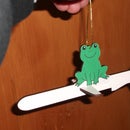Introduction: Cantilevered Glass Holder
Board games rock, but they come with problems. They often need a lot of table area and have many small pieces of paper or cardboard. This means that there is little room on the table to place a glass of wine, and if it is placed on the table then there is a risk of spillage ruining an expensive game.
The solution to this problem is a little bracket which slides onto the table-edge and holds a standard wine glass securely and conveniently. Simply by building this gizmo you _will_ win more games (as your opponents will be drinking wine).
This project took a grand total of forty-seven minutes from start to finish, including applying the varnish. Although the varnish took some time to dry afterwards, the piece works fine without a nice finish so the varnish is an optional extra.
Supplies
Scrap thin plywood
Scrap wood of the same thickness as the tabletop
Drill and bit
2" (50mm) Holesaw
2 gutter bolts plus washers
varnish/stain (optional)
Step 1: Cut the Glass Holder
I was fortunate that I had some varnished ply offcuts from a previous cabinet project which had already been fitted with 2" (50mm) holes to fit loudspeakers as part of a test rig for a later radio project.
If your scrap bin is not so furnished, then take a piece of 1/4" ply (6mm) and cut a strip about 18" long by 3 1/2" wide (450mmx80mm).
Cut the large hole so that it finishes about one inch (25mm) from the end of the strip, then cut a slot leading into the circle about 3/4" (20mm) wide. Then cut small triangles from the corners of the ends to give a smoother look.
Cut the strip to about a foot long (300mm) and then cut the corners from the other end as well.
The final photograph shows the glass sitting quite nicely in the piece of ply.
Step 2: Add the Thickness Spacer
By happy chance, I had some scrap ply which was exactly half the thickness of the table top, and it was already a very thin strip. One way or another, layer up and cut down your scraps until you have a thin piece (say 1/2" (12mm) wide) as long as your plywood strip is wide and as thick as your table top.
I offered the strip up to the plywood holding the glass to work out how much room the bowl of the glass needed, and then marked that on the ply.
I took the thickness spacers, stacked them up and drilled through both at the same time.
Then I held them onto the plywood in the correct place and drilled through that.
The first photograph above shows the plywood plus the spacer held together with the bolts (just pushed through as a test-fit).
Step 3: Make the Upper Bracket
Making the upper bracket required me to cut the other hole from my piece, but if you cut the strip as discussed previously, then just take the 6" (150mm) left over from the strip you cut.
Offer the thickness spacer to the upper bracket, drill the clearance holes and fit the bolts.
Just spin on the nuts by hand and give a test of everything by sliding the bracket onto the table (my workmate is a bit thinner than the table, but that's fine for the test).
Step 4: Final Bolt Fitting and Assembly
With the bolts just finger-tight, use a hacksaw blade to mark the excess length.
Then mount the bolts in a temporary holder and saw them to the correct length.
With everything put together, fasten the bolts firmly.
Step 5: Finishing
I took the rough edges off things with some fairly coarse sandpaper and then applied a coat of stain and varnish using a brush. The large areas of the plywood had previously been given multiple coats with quite a fine finish, so the purpose here was really to just stain the edges of the ply and the sides of the spacer pieces to roughly the right colour.
The finish isn't great, but considering the whole thing took 47 minutes, it's good enough. Please note:- I took a photograph of my watch with the finished piece in the background, but sadly I forgot to take a picture of the watch and the materials at the start, so you'll just have to take my work on that.
Step 6: Mistakes and Improvements
I used this for the first time last night and got a hugely positive reaction from my fellow gamers. Everyone had a comment or suggestion.
First the sins:-
I misaligned the upper bracket compared to the lower holder. This is not apparent in use, but is rather obvious if the bracket is sitting on its own. It doesn't affect the function, but I should have noticed when I was making the piece.
The finish isn't great as it only got one coat with fairly coarse sanding.
And future improvements:-
There were suggestions that I put a small bowl/dice-box on the upper bracket (I thought that was a great idea).
Removing the corners from the on-table end of the upper bracket would give a nicer look.
Using brass bolts would have looked better, but I didn't have any. (I would recommend using through bolts on this joint rather than relying on glue as all of the stress in going into tension through the thickness spacer.)
In terms of praise-per-unit-effort, this project blows away everything else I have ever made. I am going to make some more, either for my use or as sets for gifts. If you've read this far, and like the idea, then please vote :-)

Participated in the
1 Hour Challenge











